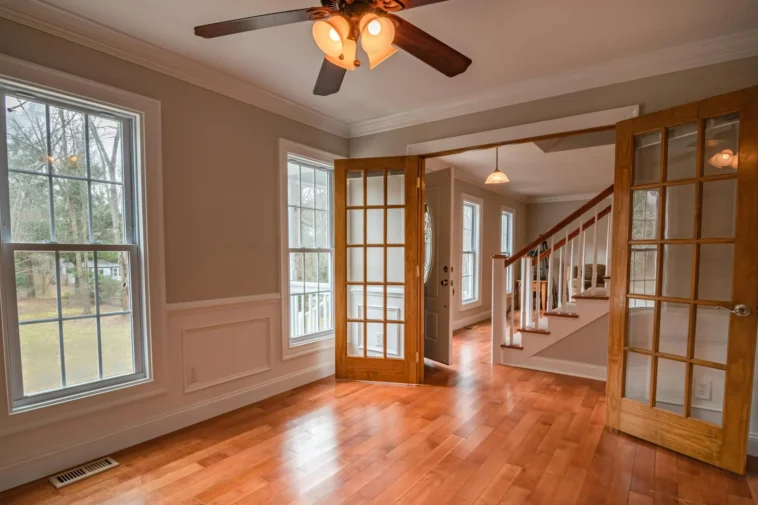At this point, you’ve probably heard about the dangers of formaldehyde, which in high doses can cause breathing issues and eye irritation, or kick off asthma. With chronic exposures, it’s also a known carcinogen. But wait! It’s even worse than you thought. A recent ProPublica investigation has found that the EPA “significantly underestimated the dangers posed by formaldehyde” by excluding the risk of getting myeloid leukemia, and underestimating the risk of asthma and reproductive harms, such as miscarriages and fertility problems.
Some of your exposure to formaldehyde is based on outdoor pollution from industrial activity and cars. But you can be exposed to formaldehyde at even higher levels indoors. “The typical home has a formaldehyde level more than three times higher than the one the EPA says would protect people against respiratory symptoms,” ProPublica found.
Take flooring. A 2015 60 Minutes investigation into Lumber Liquidators’ Chinese-made laminate flooring showed that it was likely making homeowners sick by off-gassing high levels of formaldehyde. The investigation led to a $33 million criminal penalty for Lumber Liquidators, and then a $2.5 million settlement with California’s Air Resources Board. A revised government report in 2016 said everyone living in homes with high-formaldehyde Chinese laminate flooring could experience symptoms of exposure, not just sensitive groups. Plus, between six and 30 additional people out of 100,000 could get cancer from living for two years with this laminate flooring.
After that settlement and federal standards went into effect, many retailers and brands switched to glues that emitted much lower amounts of formaldehyde. You’ll see labels saying flooring is TSCA Title VI or CARB 2 compliant, and has no added formaldehyde or ultra-low add formaldehyde.
Still, the US is arguably bad at enforcing its weak consumer protections. There’s no enforceable standard for residential indoor air. It’s also hard to know for sure that MDF products are properly labeled with the true amount of VOCs and formaldehyde in them. Lumber Liquidators is an American company that was a juicy target for lawyers. (And filed for bankruptcy this last spring.) Do you think that the random Chinese brand selling hyper-cheap laminated furniture on Wayfair is ensuring their product is compliant when it comes to formaldehyde?
The UK isn’t much better. In 2017, for example, a British couple called out their new custom MDF shelving, which cost them £18,456, for poisoning the air in their home with formaldehyde fume
Also, while some people recommend you buy an IQAir purifier, which is regarded as the best for VOCs like formaldehyde, at least one study found they can create formaldehyde as a byproduct. So if formaldehyde is your main concern, that might not work.
So, since the EPA is doing bupkis to protect you, you’ll have to protect yourself. Here are steps you can take to reduce the amount of formaldehyde in your home:
- Open the windows for fresh air in the summer, especially if your home is well-insulated and air sealed. If you live in a place with cold winters or super-hot summers that require you to keep your windows closed, install an energy recovery ventilator that brings in fresh air and circulates it.
- Replace your gas range with an induction range (if you have the budget for it), an electric range (if you have a smaller budget), or a hot plate (if you have close to no budget). A Brooklyn apartment where a gas stove was cooking and candles were burning had levels of formaldehyde “nearly 12 times the level the EPA set to protect against breathing problems and other health issues,” ProPublica reporters found. And make sure your cookstove, whatever kind, has a working hood that vents to the outside. If not, make sure to open the window nearby whenever you cook.
- Avoid varnishes and lacquers, and only use no-VOC paints.
- Buy clean and non-toxic beauty products. Especially avoid hair straightening products and conventional nail polish, which contain formaldehyde and potent formaldehyde-releasing ingredients. We have guides to non-toxic nail polish and beauty products for Black women, who are most frequently targeted by these toxic products.
- Avoid scented candles and air fresheners. Both contribute formaldehyde to your home’s air.
- Avoid fake wood, MDF, laminate wood, particle board, engineered wood or veneer furniture, cabinets, and flooring. Instead, choose uncoated metal, glass, and solid wood furniture. When choosing new wood furniture, cabinetry, and flooring, look for solid wood that locks together instead of requiring glue. Japanese style bed frames and traditional wood flooring are both great in this regard. Choose products that are made in America whenever possible. There are still a lot of wonderful furniture makers in states like North Carolina and Vermont that make high quality, solid wood, heirloom quality furniture. Here’s our guide to non-toxic furniture.
- Buy secondhand furniture! Antique shops and Facebook marketplace are filled with solid wood furniture for low prices. Even older particle-board furniture has had time to off-gas its formaldehyde. All you need is a strong friend and a borrowed or rented flatbed truck. My husband and I borrowed a truck to go pick up a solid wood Crate & Barrel 8-seat dining room table for our farmhouse and paid $300, and I got two solid wood farmhouse twin beds for $200. Or check out salvage warehouses. You can get beautiful salvaged wood, cabinets, furniture, doors, and more for a song. I owe our apartment’s cedar shelving to a trip to Big Reuse in Queens. It used to be part of an old water tower. Here are more affordable ways to get non-toxic furniture.
- For flooring, avoid fake or laminated wood floors, and wall-to-wall carpeting that is glued down. Instead, choose real wood, bricks, adobe, or linoleum, with cotton or wool throw rugs on top. I know linoleum sounds like an Age of Chemistry product, but it’s a natural, non-toxic material made of linseed oil, pine resin, wood flour, cork dust, limestone and pigments pressed together onto a jute backing. It’s an excellent choice if real wood or tile is out of your budget.
- Avoid non-wrinkle curtains, sheets, etc. They’re made non-iron through a formaldehyde-based chemical finish.
- Of course, this is obvious, but don’t allow anyone to smoke inside your home or near it. If you’re sensitive, also consider banning marijuana smoking and vapes from inside your home.




GIPHY App Key not set. Please check settings